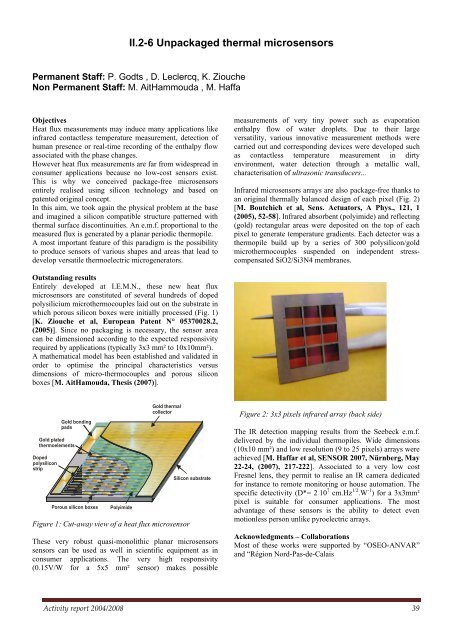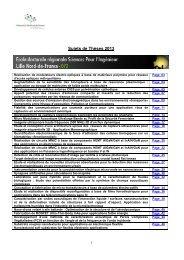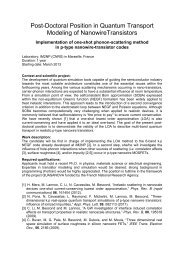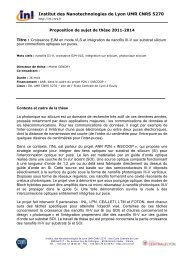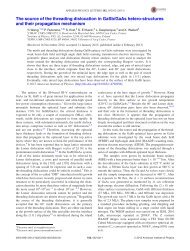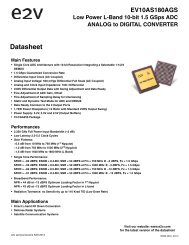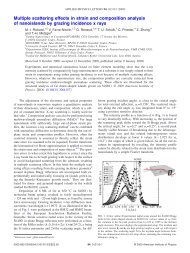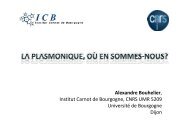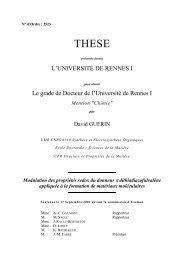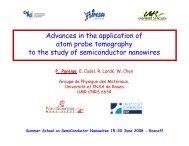Activity Report 2004-2008 (3,5 MB â 1st - IEMN
Activity Report 2004-2008 (3,5 MB â 1st - IEMN
Activity Report 2004-2008 (3,5 MB â 1st - IEMN
- No tags were found...
Create successful ePaper yourself
Turn your PDF publications into a flip-book with our unique Google optimized e-Paper software.
II.2-6 Unpackaged thermal microsensorsPermanent Staff: P. Godts , D. Leclercq, K. ZioucheNon Permanent Staff: M. AitHammouda , M. HaffaObjectivesHeat flux measurements may induce many applications likeinfrared contactless temperature measurement, detection ofhuman presence or real-time recording of the enthalpy flowassociated with the phase changes.However heat flux measurements are far from widespread inconsumer applications because no low-cost sensors exist.This is why we conceived package-free microsensorsentirely realised using silicon technology and based onpatented original concept.In this aim, we took again the physical problem at the baseand imagined a silicon compatible structure patterned withthermal surface discontinuities. An e.m.f. proportional to themeasured flux is generated by a planar periodic thermopile.A most important feature of this paradigm is the possibilityto produce sensors of various shapes and areas that lead todevelop versatile thermoelectric microgenerators.measurements of very tiny power such as evaporationenthalpy flow of water droplets. Due to their largeversatility, various innovative measurement methods werecarried out and corresponding devices were developed suchas contactless temperature measurement in dirtyenvironment, water detection through a metallic wall,characterisation of ultrasonic transducers...Infrared microsensors arrays are also package-free thanks toan original thermally balanced design of each pixel (Fig. 2)[M. Boutchich et al, Sens. Actuators, A Phys., 121, 1(2005), 52-58]. Infrared absorbent (polyimide) and reflecting(gold) rectangular areas were deposited on the top of eachpixel to generate temperature gradients. Each detector was athermopile build up by a series of 300 polysilicon/goldmicrothermocouples suspended on independent stresscompensatedSiO2/Si3N4 membranes.Outstanding resultsEntirely developed at I.E.M.N., these new heat fluxmicrosensors are constituted of several hundreds of dopedpolysilicium microthermocouples laid out on the substrate inwhich porous silicon boxes were initially processed (Fig. 1)[K. Ziouche et al, European Patent N° 05370028.2,(2005)]. Since no packaging is necessary, the sensor areacan be dimensioned according to the expected responsivityrequired by applications (typically 3x3 mm² to 10x10mm²).A mathematical model has been established and validated inorder to optimise the principal characteristics versusdimensions of micro-thermocouples and porous siliconboxes [M. AitHamouda, Thesis (2007)].DopedpolysiliconstripGold bondingpadsGold platedthermoelementsPorous silicon boxesPolyimideGold thermalcollectorFigure 1: Cut-away view of a heat flux microsensorSilicon substrateThese very robust quasi-monolithic planar microsensorssensors can be used as well in scientific equipment as inconsumer applications. The very high responsivity(0.15V/W for a 5x5 mm² sensor) makes possibleFigure 2: 3x3 pixels infrared array (back side)The IR detection mapping results from the Seebeck e.m.f.delivered by the individual thermopiles. Wide dimensions(10x10 mm²) and low resolution (9 to 25 pixels) arrays wereachieved [M. Haffar et al, SENSOR 2007, Nürnberg, May22-24, (2007), 217-222]. Associated to a very low costFresnel lens, they permit to realise an IR camera dedicatedfor instance to remote monitoring or house automation. Thespecific detectivity (D*= 2 10 7 cm.Hz 1/2 .W -1 ) for a 3x3mm²pixel is suitable for consumer applications. The mostadvantage of these sensors is the ability to detect evenmotionless person unlike pyroelectric arrays.Acknowledgments – CollaborationsMost of these works were supported by “OSEO-ANVAR”and “Région Nord-Pas-de-Calais<strong>Activity</strong> report <strong>2004</strong>/<strong>2008</strong> 39


